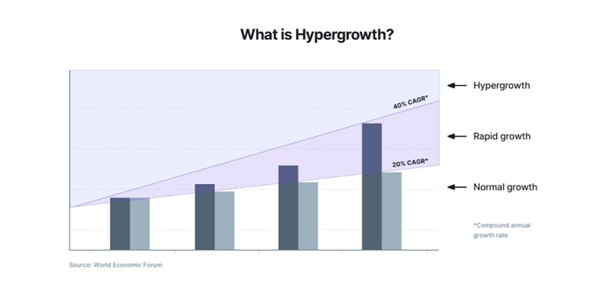Why You Should Hire a Web Development Company
Benefits of prioritizing a web development company to aid your business - particularly startups searching for tangible market shareholdings.
Amidst the rapid flux of startup culture, achieving hypergrowth is the pinnacle aspiration of any startup. What, then, is hypergrowth in startups? Hypergrowth is a term used to describe a rapid expansion rate experienced by a company, usually in its early stages. Think about companies like Airbnb, Uber, and Zoom; these are just a few examples of some of the fastest-growing startups around the world. Let’s take a look at detailed insights on hypergrowth definition and how to scale a business. We will also explore startup phases, examples of fast growing startups, and how to manage rapid business growth and expansion.

Hypergrowth refers to a phase/stage of rapid expansion when a company's compound annual growth rate (CAGR) hits 40% or more. This involves attaining an average yearly growth rate of 40% or above for a period longer than a year. The term gained prominence in the early 2000s when Alexander V. Izosimov coined the word "hypergrowth" to mean "the steep part of the S-curve that most young industries and markets experience at some point, where the winners get sorted from the losers" in a 2008 edition of Harvard Business Review. In startups, the hypergrowth stage doesn’t occur accidentally. Rather, it is the result of a prolonged, deliberate effort led by a comprehensive growth and expansion strategy that includes corporate transformation and restructuring.

Every startup has its startup phases, each of which presents its challenges and opportunities. It is important to understand these startup phases as it helps entrepreneurs navigate the complexities of business expansion effectively. Here’s a deep dive into different startup stages:
The Pre-seed phase, also known as the ideation stage, is the first stage of every startup journey. At this stage, the main goal is to identify and validate a profitable business idea. Common ways entrepreneurs develop ideas include:
More often than not, entrepreneurs underestimate the importance of this phase and skip it. It is crucial to test the product or service in the market to gather feedback and validate assumptions. When entrepreneurs skip this phase, they are likely to end up building a product that no one wants or needs, resulting in a failed business.
The execution phase tends to be the scariest phase for entrepreneurs. This is the phase where entrepreneurs have to lay everything down and take the leap of executing their plans. Most entrepreneurs often fail in this stage because they don’t efficiently turn a great idea into a great execution.
The growth phase is a pivotal stage of any startup. This is the phase where entrepreneurs are focused on scaling their business and validating the business model on a much larger scale. Key activities in this stage include:
The hypergrowth phase is also known as the “Hyperscaling” phase. This represents a major turning point where startups experience rapid and exponential growth as they scale. The Hypergrowth phase is characterized by fast expansion, scaling up client acquisition, and streamlining product or service delivery.
The maturity phase, sometimes referred to as the late stage, is when a company achieves steady revenue growth over an extended length of time with recurring, loyal customers.
It is always useful for a startup to know where it is along the continuum, this is especially for early-stage startups. We say this because your position in your startup stages can help investors, partners, and potential employees, amongst others, frame their thinking about your current growth and potential for success.
It is as simple as this, what enabled your startup to achieve an annual recurring revenue of $20 million will certainly not help you reach an $800 million ARR. It is vital to scale at crucial stages of startups. Fast growing startups need to have systems that can run their businesses efficiently and support their hypergrowth.
One of the key drivers of Hypergrowth in early stage startups is hyper-effort. For this reason, hyper growth startup typically have long work hours. Fostering a work environment where the core team believes in your mission and shares your passion will positively impact all stages of startups.
Hypergrowth necessitates the development of an innovative product that meets the changing requirements of an expanding consumer base. Entrepreneurs can achieve hyper growth startup by concentrating on refining their products, incorporating new features, and always enhancing the user experience at key stages of startups.
Any startup seeking to achieve hypergrowth needs the backing of loyal customers. This involves actively paying attention to and listening to customer feedback and implementing it into service or product development. Customer feedback plays a key role in increasing the chances of hyper growth startup. It can also contribute to developing an innovative product or service that can drive an increase, thereby creating an entirely new market.
Reports from the World Economic Forum’s survey reveal that a substantial percentage of hyper growth startups are faced with their greatest challenges when it comes to scaling. Processes and systems that used to function well for a small-sized company will most likely fail once the company begins to experience growth and expansion. Thus, scalable business systems are essential for surviving hypergrowth.
In order to achieve hypergrowth, culture and mission stand as indispensable pillars for entrepreneurs. A startup's culture and mission are like its DNA and shape how team members work together towards common goals. It includes common norms, beliefs, and behaviors that specify how members of a team communicate, work together, and pursue objectives. Startups need a culture of openness, responsibility, and inclusion. When your team believes in what they are doing, they stay motivated and get more done.
Startups seeking to achieve hypergrowth need to prioritize sustainability over rapid growth to ensure long-term viability and resilience. This involves making deliberate choices and exercising restraint, even when lucrative opportunities arise. Prioritizing sustainability can help startups build a solid foundation for future success.
One effective way for early stage startups to achieve hypergrowth is the innovative use of technology. This involves using technology to gain valuable insights, optimize processes, react to changes with speed, foster connections between teams, and lower costs, among other things. For instance, when it comes to client-facing apps, JavaScript is the prevailing language for startups aiming for growth, with other languages like AngularJS and React being the popular libraries. The advantageous features of these languages align with the agility and speed requirements of startups seeking expansion. Startups lacking the in-house expertise to manage web or app development projects can opt to outsource and hire developers for startup ventures.
Premature scaling is one of the common challenges that companies can face at any of the stages of startups. Although hypergrowth equals preparedness to scale, it is among the leading causes of startup failures. Even a late stage startup without a consistent startup growth strategy can fall victim to the “too fast, too soon” approach.
Achieving hypergrowth at any of the startup stages means the business will need to spend more money to market its business efficiently. Without proper planning and a thorough reevaluation of marketing strategies for lower-cost solutions, startups can fail.
It is always expected that employees during the hypergrowth stage may have to work extra long hours. However, if employees are overworked, they can get burned out, and this will affect their ability to work well. At this point, hyper growth startup culture can become toxic and unsustainable.
At early stage startups, all the way to late stage startups, it is vital to have clear priorities. This involves defining strategic objectives, identifying key metrics, and milestones that indicate progress toward goals. Clear priorities will enable a business to allocate resources effectively and focus on innovations that are in line with its priorities.
Agile methodologies can help startups streamline processes and improve collaboration. Agile methodologies like Scrum or Kanban may help teams keep up the momentum and consistently improve quality by breaking down projects into smaller, more manageable jobs and iterating quickly based on feedback and insights. Startups may also explore the option of hiring Agile teams to oversee this aspect of their operations.
Leveraging automated technology can handle routine processes and save time. It will allow teams to focus on initiatives that drive innovation and quality. Identifying repetitive tasks can aid in achieving a balance between speed and quality in the business.
Scalable infrastructure is essential for supporting rapid growth without compromising performance. This involves investing in scalable architectures and cloud-based solutions that can quickly adapt to evolving business needs and increasing demands. This ensures that you can scale efficiently.
Having a business exit strategy in place is vital. It is important to prepare for any situations in which maintaining a rapid growth rate becomes difficult. A business exit strategy offers a road map for capital optimization, risk reduction, and long-term planning. A few types of exit strategies include: Selling your stake to an investor or partner, Initial Public Offering (IPO), family succession, and Liquidation etc.
Zoom tops our list of successful hypergrowth startups. The rapid growth and expansion of Zoom can be attributed to the lockdown that followed the COVID-19 pandemic. During this period, it had over 200 million participants every single day. Zoom adopts a customer-centric approach.
Industry giants like Amazon and Shopify commonly use Stripe to process payments. It started out as a straightforward, borderless program and has grown into a powerful platform for companies looking to expand their digital transformation. In addition, Stripe's immersive customer experience allowed them to stay in close contact with their consumers.
Bolt, which was previously called Taxify, is an Estonian transportation service that launched in 2013. It was founded by a 19-year-old and funded through a family loan. Now, it is widely known as one of the most successful startups worldwide. Bolt has over 25 million customers in 30 countries.
You can find startup companies through various mediums. These include using a startup directory, using a platform like AngelList or Crunchbase, startup hubs, accelerators, and networking events.
The Inc 5000 list has been produced every year since the year 1982. It basically analyzes company data to rank the fastest-growing privately held businesses in the US.
Putting in place a business exit strategy is essential for aligning long-term goals, mitigating risks, and fulfilling investor expectations. In the face of shifting market conditions and entrepreneurial pursuits, a business exit strategy strengthens the longevity and success of companies.
Rapid business growth is a coveted goal for startups, yet achieving hypergrowth is no simple feat. In this article, we have explored vital strategies and tips that can help startups navigate the journey successfully. If you are looking to hire developers for startup ventures, YouDigital specializes in helping businesses transition to a period of smooth and sustainable growth. Reach out to us today to explore how we can propel your startup forward.
Benefits of prioritizing a web development company to aid your business - particularly startups searching for tangible market shareholdings.
Risk is undoubtedly a crucial part of any business. You might need to undertake some risks to get ahead of the competition. Most companies have an
As businesses seek to expand their operations, the need to scale software development, develop software in Poland and cut costs will become even more prominent.
REQUEST PROFILE